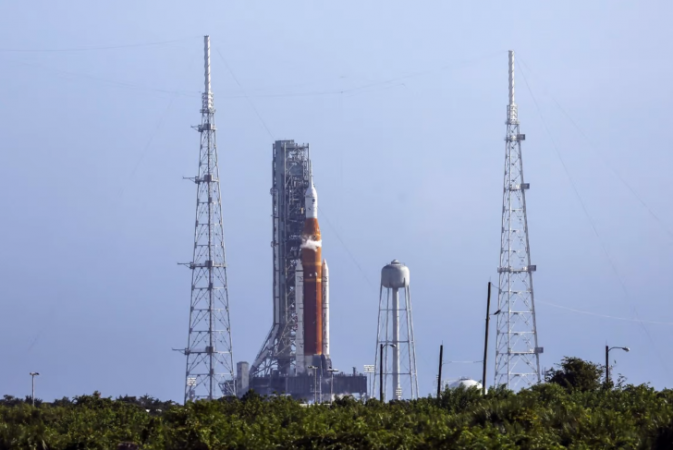
USA: The launch of Nasa's massive, next-generation rocket was aborted on Saturday for the second time in a week due to a persistent fuel leak, which the space agency said could push back the launch of its moon-to-Mars Artemis programme by at least a few weeks.
Three hours prior to the scheduled 2:17pm EDT lift-off of the 32-story Space Launch System (SLS) rocket and its Orion capsule from Cape Canaveral, Florida, preflight operations were suspended for the day.
Half a century after the last lunar mission of Apollo, the predecessor of the Artemis programme, the unmanned test flight, intended to send the capsule to the moon and back, was to be the first flight of the SLS and Orion.
Half a century after the last lunar mission of the predecessor to the Artemis programme, Apollo, the unmanned test flight of the SLS and Orion was to have been the first flight of both rocket systems. It was intended to launch the capsule out to the moon and back.
After several unsuccessful attempts to fix a "large" leak of supercooled liquid hydrogen propellant being pumped into the rocket's core-stage fuel tanks by Kennedy Space Centre technicians, the countdown was aborted, according to agency officials.
Technical issues, such as a different leaky fuel line, a flawed temperature sensor, and cracks found in the insulation foam, also prevented the initial launch attempt on Monday.
After the earlier issues were satisfactorily resolved on Saturday, mission managers moved forward with a second launch attempt. In case a third attempt was required, NASA had set aside a second backup launch window for either Monday or Tuesday.
However, after analysing data from the most recent issues, Nasa came to the conclusion that the hydrogen leak was too difficult and time-consuming to resolve on the launch pad before the mission's current launch window expires on Tuesday.
An associate NASA administrator named Jim Free informed reporters at a late-afternoon briefing that due to the delay, the earliest opportunity to try flying the rocket again would come during the next launch period, which runs from September 19–30, or during a subsequent October window.
According to "range" regulations set forth by the space centre, which place a time limit on how long a rocket may stay at the tower before taking off, the postponement would also require rolling the spacecraft off the launch pad and back into its assembly building at some point. In part to avoid a scheduling conflict with the upcoming International Space Station crew scheduled to launch early that month, NASA Administrator Bill Nelson stated earlier in the day that a rollback would push back the next launch attempt at least until mid-October. In the space industry, launch-day delays and technical difficulties are common, particularly for new rockets like NASA's Space Launch System, a complex vehicle with a number of pre-lift-off procedures that have not yet been fully tested and perfected by engineers.
An average of one in three launches are cancelled on any given day for any reason, including bad weather.
Be prepared for scrubs because this is a part of our space programme, Nelson said on NASA TV.
The last-minute setbacks on the launch pad come at the end of a development programme that has taken more than ten years to complete. Under NASA's respective SLS and Orion contracts with Boeing Co. and Lockheed Martin Corp., there have been years of delays and billions of dollars in cost overruns.
After decades of focusing on low-Earth orbit with space shuttles and the International Space Station, Artemis I marks a significant turning point for NASA's post-Apollo human spaceflight programme, despite its technical difficulties.
Though many experts think that target date will slip, Artemis, named for the goddess who was Apollo's twin sister in ancient Greek mythology, hopes to bring astronauts back to the moon's surface as early as 2025.
The six Apollo missions, which took place between 1969 and 1972, featured twelve astronauts walking on the moon. These missions were the only ones to date to send people to the moon. Apollo, however, was less science-focused than Artemis and was a product of the Cold War space race between the US and the USSR.
In order to eventually establish a long-term lunar base of operations as a stepping stone to even more ambitious human missions to Mars, the new moon programme has enlisted the assistance of commercial partners like SpaceX and the space agencies of Europe, Canada, and Japan.
One of the most important first steps is launching the SLS-Orion spacecraft. The 5.75 million pound spacecraft will undergo a rigorous test flight on its first trip to prove that it is capable of carrying astronauts by pushing the spacecraft's design limits.
If the mission is successful, a crewed Artemis II flight around the moon and back could happen as early as 2024, and the program's first lunar landing of astronauts—one of them a woman—with Artemis III will follow a few more years after that.
The SLS is the largest new vertical launch system NASA has constructed since the Saturn V of the Apollo era and is marketed as the most potent, sophisticated rocket in the world.
Orion will carry a simulated crew of three, consisting of one male and two female mannequins, even though there won't be any actual humans on board. These mannequins will be outfitted with sensors to measure radiation levels and other stresses that actual astronauts would encounter.
This Saturday, NASA will attempt another launch of Artmis 1
Asteroid heading for a close encounter with Earth on August 26, NASA warns
NASA has given the planned August 29th Artemis I moon mission the "go-ahead"